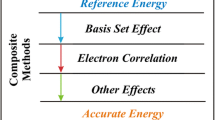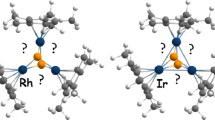Abstract
In multireference calculations on transition metal compounds, large active spaces including a second set of d orbitals are often used. However, with the increase in the system size and the complexity of the method, such calculations quickly become impractical. In this work, we looked for an inner valence active space for atomic cobalt and its hydride that correctly describes the transition energies among states with distinct configurations. Potential energy curves for the CoH molecule were obtained using a fixed reference space, where the orbitals are optimised only for the isolated atoms, avoiding undesirable sudden variations of the active orbitals. The calculations made use of the multireference configuration interaction (MRCI) and coupled-cluster (MRCC) theories. The accuracy of these calculations is carefully analysed, and we show that MRCC results are accurate, although not all electronic states are quantitatively described at the MRCI level. We conclude that the use of the fixed reference space is a viable approach to reduce the computational cost when large active spaces are prohibitive. Finally, a careful comparison of the present results with experimental values is carried out.




Similar content being viewed by others
References
Lischka H, Nachtigallová D, Aquino AJA, Szalay PG, Plasser F, Machado FBC, Barbatti M (2018) Multireference approaches for excited states of molecules. Chem Rev. https://doi.org/10.1021/acs.chemrev.8b00244
Hay PJ (1977) Gaussian basis sets for molecular calculation. The representation of 3\(d\) orbitals in transition-metal atoms. J Chem Phys. https://doi.org/10.1063/1.433731
Botch BH, Dunning TH Jr, Harrison JF (1981) Valence correlation in the \(s^2d^n\), \(sd^{n+1}\), and \(d^{n+2}\) states of the first-row transition metal atoms. J Chem Phys. https://doi.org/10.1063/1.442456
Bauschlicher CW Jr, Siegbahn P, Pettersson LGM (1988) The atomic states of nickel. Theor Chim Acta. https://doi.org/10.1007/BF00528018
Andersson K, Roos BO (1992) Excitation energies in the nickel atom studied with the complete active space SCF method and second-order perturbation theory. Chem Phys Lett. https://doi.org/10.1016/0009-2614(92)85581-T
Balabanov NB, Peterson KA (2006) Basis set limit electronic excitation energies, ionization potentials, and electron affinities for the 3\(d\) transition metal atoms: coupled cluster and multireference methods. J Chem Phys. https://doi.org/10.1063/1.2335444
Lyakh DI, Musiał M, Lotrich VF, Bartlett RJ (2012) Multireference nature of chemistry: the coupled-cluster view. Chem Rev. https://doi.org/10.1021/cr2001417
Köhn A, Hanauer M, Mück LA, Jagau T-C, Gauss J (2012) State-specific multireference coupled-cluster theory. WIREs Comput Mol Sci. https://doi.org/10.1002/wcms.1120
Aoto YA, Köhn A (2016) Revisiting the \(\text{ F }+\text{ HCl }\rightarrow \text{ HF }+\text{ Cl }\) reaction using a multireference coupled-cluster method. Phys Chem Chem Phys. https://doi.org/10.1039/C6CP05782A
Sakellaris CN, Mavridis A (2012) First principles study of cobalt hydride, CoH, and its ions \(\text{ CoH }^+\) and \(\text{ CoH }^-\). J Chem Phys. https://doi.org/10.1063/1.4734595
Kramida A (2018) Atomic energy levels and spectra bibliographic database (version 2.0). Natl Inst Stand Technol. https://doi.org/10.18434/T40K53
Langhoff SR, Davidson ER (1974) Configuration interaction calculations on the nitrogen molecule. Int J Quantum Chem. https://doi.org/10.1002/qua.560080106
Werner H-J, Kállay M, Gauss J (2008) The barrier height of the F\(+\text{ H }_2\) reaction revisited: coupled-cluster and multireference configuration-interaction benchmark calculations. J Chem Phys. https://doi.org/10.1063/1.2822905
Hanauer M, Köhn A (2012) Perturbative treatment of triple excitations in internally contracted multireference coupled cluster theory. J Chem Phys. https://doi.org/10.1063/1.4718700
Deskevich MP, Nesbitt DJ, Werner H-J (2004) Dynamically weighted multiconfiguration self-consistent field: multistate calculations for F\(+\text{ H }_2\text{ O }\rightarrow \text{ HF }+\text{ OH }\). J Chem Phys. https://doi.org/10.1063/1.1667468
Sayfutyarova ER, Sun Q, Chan GK-L, Knizia G (2017) Automated construction of molecular active spaces from atomic valence orbitals. J Chem Theory Comput. https://doi.org/10.1021/acs.jctc.7b00128
Evangelista FA, Gauss J (2011) An orbital-invariant internally contracted multireference coupled cluster approach. J Chem Phys. https://doi.org/10.1063/1.3559149
Gordon IE, Le Roy RJ, Bernath PF (2006) Near infrared emission spectra of CoH and CoD. J Mol Spectrosc. https://doi.org/10.1016/j.jms.2006.02.011
Varberg TD, Hill EJ, Field RW (1989) Laser spectroscopy of CoH: spin–orbit splitting of the ground state. J Mol Spectrosc. https://doi.org/10.1016/0022-2852(89)90023-4
Miller AES, Feigerle CS, Lineberger WC (1987) Laser photoelectron spectroscopy of CrH–, CoH–, and NiH–: periodic trends in the electronic structure of the transition-metal hydrides. J Chem Phys. https://doi.org/10.1063/1.453214
Barnes M, Merer AJ, Metha GF (1995) Rotational and hyperfine analysis of the \(A^{\prime 3}\Phi _4-X^3\Phi _4\) transitions of CoH and CoD. J Mol Spectrosc. https://doi.org/10.1006/jmsp.1995.1222
Aoto YA, de Lima Batista AP, Köhn A, de Oliveira-Filho AGS (2017) How to arrive at accurate benchmark values for transition metal compounds: computation of experiment? J Chem Theory Comput. https://doi.org/10.1021/acs.jctc.7b00688
Cheng L, Gauss J, Ruscic B, Armentrout PB, Stanton JF (2017) Bond dissociation energies for diatomic molecules containing 3d transition metals: benchmark scalar-relativistic coupled-cluster calculations for 20 molecules. J Chem Theory. https://doi.org/10.1021/acs.jctc.6b00970
Tomonari M, Okuda R, Nagashima U, Tanaka K, Hirano T (2007) Ab initio calculation of the electronic structures of the \(^3\Phi\) ground and \(^5\Phi\) excited states of CoH. J Chem Phys. https://doi.org/10.1063/1.2711193
Shee J, Rudshteyn B, Arthur EJ, Zhang S, Reichman DR, Friesner RA (2019) On achieving high accuracy in quantum chemical calculations of 3\(d\) transition metal-containing systems: a comparison of auxiliary-field quantum monte carlo with coupled cluster, density functional theory, and experiment for diatomic molecules. J Chem Theory Comput. https://doi.org/10.1021/acs.jctc.9b00083
Wang H, Zhuang X, Steimle TC (2009) The permanent electric dipole moments of cobalt monofluoride, CoF, and monohydride, CoH. J Chem Phys. https://doi.org/10.1063/1.3226672
Banerjee A, Simons J (1981) The coupled-cluster method with a multiconfiguration reference state. Int J Quantum Chem. https://doi.org/10.1002/qua.560190203
Hanauer M, Köhn A (2011) Pilot applications of internally contracted multireference coupled cluster theory, and how to choose the cluster operator properly. J Chem Phys. https://doi.org/10.1063/1.3592786
Wolf A, Reiher M, Hess BA (2002) The generalized Douglas–Kroll transformation. J Chem Phys. https://doi.org/10.1063/1.1515314
Reiher M, Wolf A (2004) Exact decoupling of the Dirac Hamiltonian. I. General theory. J Chem Phys. https://doi.org/10.1063/1.1768160
Reiher M, Wolf A (2004) Exact decoupling of the Dirac Hamiltonian. II. The generalized Douglas–Kroll–Hess transformation up to arbitrary order. J Chem Phys. https://doi.org/10.1063/1.1818681
Dunning TH Jr (1989) Gaussian basis sets for use in correlated molecular calculations. I. The atoms boron through neon and hydrogen. J Chem Phys. https://doi.org/10.1063/1.456153
de Jong WA, Harrison RJ, Dixon DA (2001) Parallel Douglas–Kroll energy and gradients in NWChem: estimating scalar relativistic effects using Douglas–Kroll contracted basis set. J Chem Phys. https://doi.org/10.1063/1.1329891
Balabanov NB, Peterson KA (2005) Systematically convergent basis sets for transition metals. I. All-electron correlation consistent basis sets for the 3\(d\) elements Sc–Zn. J Chem Phys. https://doi.org/10.1063/1.1998907
Berning A, Schweizer M, Werner H-J, Knowles PJ, Palmieri P (2000) Spin-orbit matrix elements for internally contracted multireference configuration interaction wavefunctions. Mol Phys. https://doi.org/10.1080/00268970009483386
Halkier A, Helgaker T, Jørgensen P, Klopper W, Olsen J (1999) Basis-set convergence of the energy in molecular Hartree–Fock calculations. Chem Phys Lett. https://doi.org/10.1016/S0009-2614(99)00179-7
Werner H-J, Knowles PJ (1988) An efficient internally contracted multiconfiguration-reference configuration interaction method. J Chem Phys. https://doi.org/10.1063/1.455556
Knowles PJ, Werner H-J (1988) An efficient method for the evaluation of coupling coefficients in configuration interaction calculation. Chem Phys Lett. https://doi.org/10.1016/0009-2614(88)87412-8
Knowles PJ, Werner H-J (1992) Internally contracted multiconfiguration-reference configuration interaction calculations for excited states. Theor Chim Acta. https://doi.org/10.1007/BF01117405
Werner H-J, Knowles PJ, Knizia G, Manby FR, Schütz M, et al. MOLPRO, version 2019 a package of ab initio programs. see http://www.molpro.net
Samanta PK, Köhn A (2018) First-order properties from internally contracted multireference coupled-cluster theory with particular focus on hyperfine coupling tensors. J Chem Phys. https://doi.org/10.1063/1.5040587
Werner H-J, Knowles PJ (1985) A second order multiconfiguration SCF procedure with optimum convergence. J Chem Phys. https://doi.org/10.1063/1.448627
Knowles PJ, Werner H-J (1985) An efficient second-order MC SCF method for long configuration expansios. Chem Phys Lett. https://doi.org/10.1016/0009-2614(85)80025-7
Acknowledgements
We are very thankful to Andreas Köhn for the release of the GeCCo programme and to Pradipta Kumar Samanta for the assistance on the calculations of icMRCC dipole moments. Y.A.A. is grateful to Márcio Fabiano da Silva for the kind support. This research has been supported by Grants #2017/21199-0, #2018/04617-6 and #2018/14629-1, São Paulo Research Foundation (FAPESP). This study was financed in part by the Coordenação de Aperfeiçoamento de Pessoal de Nível Superior—Brasil (CAPES)—Finance Code 001.
Author information
Authors and Affiliations
Corresponding author
Additional information
This work is dedicated to Professor Fernando Rei Ornellas on the occasion of his 70th birthday.
Publisher's Note
Springer Nature remains neutral with regard to jurisdictional claims in published maps and institutional affiliations.
“Festschrift in honor of Prof. Fernando R. Ornellas” Guest Edited by Adélia Justino Aguiar Aquino, Antonio Gustavo Sampaio de Oliveira Filho & Francisco Bolivar Correto Machado.
Electronic supplementary material
Below is the link to the electronic supplementary material.
Rights and permissions
About this article
Cite this article
de Moraes, M.M.F., Aoto, Y.A. Reference spaces for multireference coupled-cluster theory: the challenge of the CoH molecule. Theor Chem Acc 139, 71 (2020). https://doi.org/10.1007/s00214-020-2584-1
Received:
Accepted:
Published:
DOI: https://doi.org/10.1007/s00214-020-2584-1




